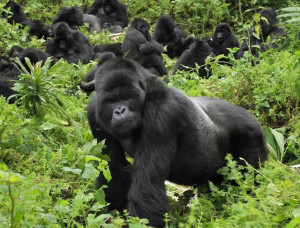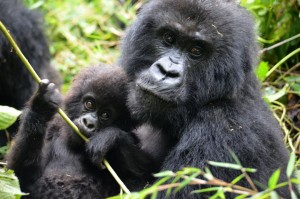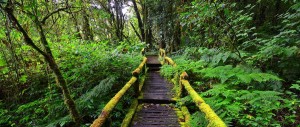Volcanoes National Park.
Volcanoes National Park is the Rwandan section of the great volcanic massif called the Virunga Mountains that straddles the borders of Rwanda, Uganda and the DRC. The massif covers a huge area of over 8,000km², encompassing six active and three extinct volcanoes. Gorillas, of course, pay no heed to borders and are known to cross between the countries, although most habituated groups are to be found in Volcanoes National Park. The massif is home to around half of the world’s precious mountain gorillas – some 400 of them – making Rwanda probably the best place in Africa for a tracking safari.
Volcanoes National Park also has a historic connection with gorilla conservation. It was the base for the ground-breaking work of primatologist Dian Fossey which started in the late 1960s and is evocatively portrayed in the book and film Gorillas in the Mist.
Safaris to Volcanoes National Park
The town of Musanze also more commonly known by its former name Ruhengeri is the hub of Rwanda’s gorilla trekking tourism, with plenty of cafes, bars and restaurants, and is easily accessible on a 1-2 hour drive from the capital Kigali. Volcanoes National Park’s Headquarters are based in the nearby village of Kinigi, the administrative centre for permits and the place where all visitors gather in the mornings for briefings before starting on their gorilla treks.
The issuing of gorilla tracking permits is strictly regulated in Volcanoes National Park so it’s advisable to plan your holiday well ahead, particularly if you want to travel to Rwanda in the busy period between June and September, to guarantee availability.
Safari camps and lodges in and around Volcanoes
There are several options for accommodation near Volcanoes National Park, and quite a range of choices from simple and basic, to more upmarket. Those in Ruhengeri and Kinigi generally fall into the lower budget categories while the more expensive lodges can be found on the outskirts of the park or scattered further afield.
Tourism in Volcanoes National Park is well established. For the most part, the gorilla tracking experiences and hotels operate smoothly and the people are friendly, appreciating the value of visitors to their economy and their area. Indeed, some of the lodges actively work with the local communities on projects for job creation and education, offering interesting visits to local villages.
Activities on a Volcanoes National Park holiday
Gorilla tracking safaris in Volcanoes National Park
There is no other wildlife experience quite like an encounter with mountain gorillas. That precious hour spent in their company – watching the group playing, sulking, teasing each other, eating, or dozing just like we do – is extraordinary. And the gorilla tracking safaris in Rwanda’s Volcanoes National Park are among the best in Africa.
Rwanda is now home to ten habituated groups of mountain gorillas that are scattered all over Volcanoes National Park. You’ll leave early in the morning for your briefing at the Park HQ and then in parties of eight will be taken to your allocated group with a guide and trackers. Gorilla trekking can be arduous – some of the groups wander high up the mountainsides – but it is always utterly rewarding.
Other Trips in Volcanoes National Park
You don’t have to track gorillas to go trekking in Volcanoes National Park – there are other interesting hiking trails here. Before your visit to the gorillas, a guided walk into the mountains can be good for acclimatization. It also allows you to spend more time looking at the other wildlife in forest, and to gain a better understanding of the overall ecosystem.
One of the more popular routes is to the tomb of Dian Fossey and the Karisoke Research Centre she established, which takes a couple of hours of fairly steep walking. Another beautiful option is a day hike to the crater lake on Mount Bisoke.
Several other primates have made Volcanoes National Park their home too and it’s possible to track two troops of habituated golden monkeys, a totally different experience to gorilla tracking. Golden monkeys tend to inhabit the bamboo forests on the lower slopes, so the walk to reach them is relatively easy. Again, once you find them, you’ll have just an hour in their presence. They’re fast-moving little creatures, and very entertaining as they constantly swing through the bamboo or chase each other in circles all around you. They’re also very pretty, with shiny reddish-gold backs that blend in perfectly with the golden bamboo.
People are as much a part of Volcanoes National Park as its primates and a visit to one of the cultural centres in the area to gain an insight into local life and traditions is not only very interesting but also benefits the local communities and deters them from engaging in negative activities like poaching. Two very good examples are the SACOLA Cultural Centre, with excellent traditional Intore dancing, and Iby’Iwacu Cultural Village, both near Kinigi.
Wildlife of Volcanoes National Park
Even without mountain gorilla safaris, Volcanoes National Park would be fascinating. Its altitude ranges from about 2,500m to the peak of Karisimbi, at 4,500m, resulting in extensive bamboo forests and some of the last remaining afro-montane forest habitat on the planet. On the higher slopes you’ll find an almost otherworldly habitat of thick moors with endemic giant lobelia and groundsel.
As well as its infamous mountain gorillas, the Park harbours a spectacular array of rare and endangered animals and plants. There is a variety of other primates, including the endemic golden monkeys, plus forest elephants, buffalo, giant forest hogs (Africa’s largest swine), bushpigs, bushbucks, black-fronted duikers, spotted hyenas, and around 200 species of birds.




